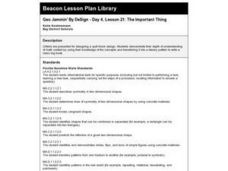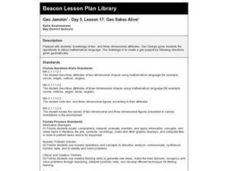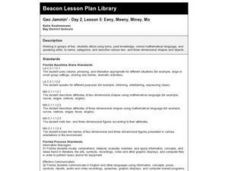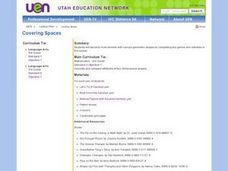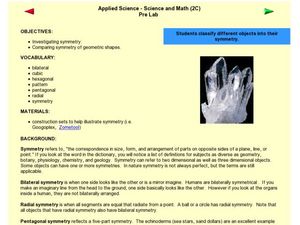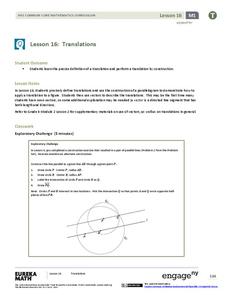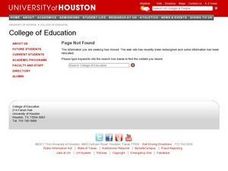Curated OER
Fractal and the Dragon Curve
Students explore Fractal designs. In this geometry lesson, students observe the different polygons created in nature and relate it to math. They define polygons on planes and rotate polygons about a point.
Curated OER
Geo Jammin By Design: The Important Thing
Students brainstorm what they know about geometric terms and patterns. They identify symmetry, shapes and congruency. They create a book of symmetry.
Curated OER
Geo Jammin' - Day 5, Lesson 17: Geo Sakes Alive!
Second graders, given geometric instructions, try to create their own Geo George puppet.
Curated OER
Geo Jammin' - Day 2, Lesson 5: Eeny, Meeny, Miney, Mo
Students, in groups, use song lyrics and math to descrie two and three dimensional shapes.
Curated OER
Covering Spaces
Third graders become more familiar with various geometric shapes by completing the games and activities in this instructional activity. They keep track of the number of each shape they use in each of the three ways.
Curated OER
Symmetry
Sixth graders explore symmetry and discuss the difference between a rotation and reflection. Using hands-on activities, such as folding paper shapes, they discover how to find the lines of symmetry and symmetrical characteristics. As a...
Curated OER
Geo Jammin' By DeSign - Day 5, Lesson 24: Read All About It!
Students listen to The Important Thing About Quilt Design and rewrite an original version using geometric terms.
Curated OER
Translations
Students explore the concept of translations. In this translations lesson, students discuss similarities and differences between images and pre-images. Students apply translations to coordinates of figures. Students use patty paper to...
Curated OER
Area Pre- Test
In this area worksheet, 6th graders take a pre-test about what they may already know pertaining to geometric area. Students respond to 10 multiple choice questions.
Curated OER
Our Tangible World is Full of Dimensions
Sixth graders explore characteristics of two and three-dimensional figures. They observe the teacher demonstrate the faces, edges, vertices and names of specific figures. In groups, 6th graders examine and describe given figures. ...
Curated OER
Manipulative Mania
Students explore tangram vocabulary and tangram designs, creating an art design that contains various geometric parts. They complete a checklist titled, Important Thing About a Quilt Design.
Curated OER
Unit Perimeters and Areas
Students use Geometers SketchPad to find the area and perimeter of several shapes. In this geometry lesson, students determine area of rectangles and progress through irregular polygons. None of the referenced worksheets are included...
Curated OER
Making Tangram Pieces by Folding Paper
Third graders follow directions to make a set of tangram pieces. After reading a story, they compare and contrast the differences between two-dimensional shapes. To end the lesson, they use the tangram pieces to create their own...
Curated OER
Mobius Band
Tenth graders discuss sides of a shape and how to collect data correctly. For this geometry lesson, 10th graders examine shapes and count the surfaces on the shape. They read the history of Mobius Band and relate it to surface area.
Curated OER
Coconut-Shell Cup
High schoolers research and discuss the social ritual of drinking chocolate in viceregal Mexico. They explain its cultural and historical and geographical roots. Students create their own "drinking" vessel from papier-mache. They...
Curated OER
Cultural Cups
Students create their own drinking vessel from papier-m??ch??. They experiment with different shapes for drinking vessels and different patterns for them.
Curated OER
Lines, Rays, Line Segments, and Planes
High schoolers are introduced to lines, rays, line segments and planes and study the differences between them. They also practice graphing lines, rays, line segments and planes
Curated OER
Bubble and Boyle
Even middle schoolers still enjoy experimenting with bubbles! They execute a series of experiments enabling them to distinguish between convex and concave surfaces, explore the properties of buoyancy, surface tension, and density,...
Mathematics Vision Project
Module 6: Congruence, Construction, and Proof
Trace the links between a variety of math concepts in this far-reaching unit. Ideas that seem very different on the outset (like the distance formula and rigid transformations) come together in very natural and logical ways. This unit...
Noyce Foundation
Parallelogram
Parallelograms are pairs of triangles all the way around. Pupils measure to determine the area and perimeter of a parallelogram. They then find the area of the tirangles formed by drawing a diagonal of the parallelogram and compare their...
Curated OER
Pattern Block Fractions
Fourth graders participate in a lesson that is about the finding of different fractional sizes with the help of pattern blocks. They define the vocabulary terms of numerator and denominator. The lesson also uses geometry and relates it...
Shodor Education Foundation
Pythagorean Theorem
Most adults remember learning about the Pythagorean theorem, but they don't all remember how to use it. The emphasis here is on developing an intuitive understanding of how and when to use the theorem. Young mathematicians explore...
Noyce Foundation
Which is Bigger?
To take the longest path, go around—or was that go over? Class members measure scale drawings of a cylindrical vase to find the height and diameter. They calculate the actual height and circumference and determine which is larger.



